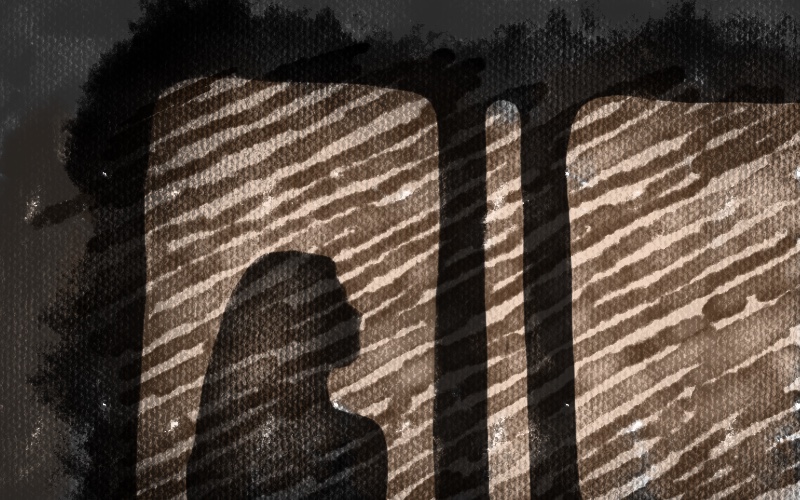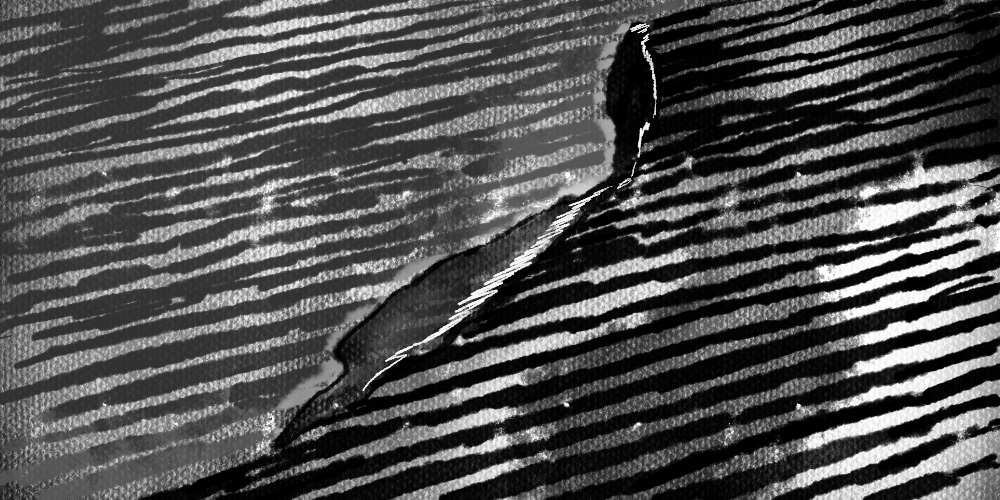Have you ever caught yourself staring at a shadow? Almost everyone has. What is it that makes these fleeting images so compelling? It’s an odd feeling to see something that technically is not there but at the same time is unmistakably present. The mind immediately struggles to make sense of this phantasm, either trying to figure out what is casting the shadow or, more often perhaps, turning the shadow into a symbol of something else. In either case, the shadow provides an opportunity for us to see things anew. Ultimately, that is the power of shadows, and the reason they are so good at arresting attention. Shadows are a place to court the unexpected, to let the mind explore. As transitory images produced on the border between light and darkness, shadows occupy an in-between space that challenges us to make sense of their vague and shifting outlines.
Shadows have always been contested space. While we use “shadow” quite freely, as the esteemed art historian E.H. Gombrich has noted in Shadows: The Depiction of Cast Shadows in Western Art, there is actually quite a bit of ambiguity in the term. A shadow can simply be the occlusion of light, or it can be a cast shadow or silhouette that is surprisingly distinct. And while shadows typically denote darkness, they are not the complete absence of light, but rather an in-between color that varies depending on the strength of the illuminating source, the opaqueness of the object that casts it, and the quality of the surface on which it appears. Popular use has provided even more meanings, from the sinister idea of something dangerous “lurking in the shadows” to the more benign, like the idea of being influenced or “overshadowed” by another. Shadows are hard to pin down.
While shadows catch our attention with almost magical quality, it is when we begin to interpret shadows that they become even more interesting and complicated. Perhaps the best-known employer of shadow imagery is still Plato. In his famous “Allegory of the Cave” section of The Republic, Plato describes a group of prisoners chained to the wall, forced to watch shadows cast by figures they cannot see. While the prisoners believe the shadows are real, when they escape the cave they realize the trick — it’s the sun that is the true source of meaning, not the shadows the figures produce. With light figured as understanding throughout the Western world (God begins, after all, by separating light from darkness), the idea that shadows are deceptive and false becomes a necessary corollary.
Yet shadows are not so easily dismissed as aberration. We humans have also been looking to them for centuries as stand-ins for our souls. Pliny the Elder, writing in the first century of the Common Era, claimed that painting began with the tracing of a shadow, and this desire to capture the outline of a loved one was only the beginning of a demand for silhouettes that would culminate in the practice of photography, which the Chinese define literally as the absorbing or taking in of a reflection or shadow. Ancient cave drawings, Egyptian mummies, and stories where someone loses their shadow all operate on the same connection between shadow and soul. This idea has had remarkable staying power. In the book of Acts (5:15), Peter’s shadow can cure the sick, and even today we all know that a vampire casts no shadow because he has forfeited his soul. This type of thinking has seeped into psychoanalysis as well. Shadows are examples of an uncanny “return of the repressed” for Sigmund Freud, and they symbolize unconscious fears and desires for Carl Gustav Jung. It’s a connection that’s hard to shake.
Yet for many, the real appeal of shadows is that they stimulate the imagination, providing an opening for thought to emerge. The Japanese novelist Junichirō Tanizaki, in his 1933 treatise In Praise of Shadows, laments a Westernization of Japan that brings the desire for illumination in its wake, opting instead for a more traditional reliance on shadows that lend “mystery” and “depth” to life. The ambiguity of the shadow allows us to approach a topic from a new angle, to take a new tack. Take, for example, the classic television series The Twilight Zone. In order to discuss such delicate matters as nuclear anxiety, racial tension, and suburban conformity, Rod Serling asked viewers to journey each week to what he called “a land of shadows” where normal rules and expectations break down. In the Twilight Zone, shadows became the place where the dualistic thinking of the era was challenged with strange, twisting tales that caught viewers off guard. The visual feel of the majority of the episodes, populated by shadow and chiaroscuro, worked in tandem with the show’s content to create a world where the common assumptions of the Cold War were interrogated and, oftentimes, overturned.
The Twilight Zone demonstrates another reason for the continued relevance of shadows — they can easily be used for social critique. Shadows are a timeless phenomenon, but they are often read within the culture of a particular moment. The Cold War offers a perfect example. Although the atomic bomb was initially described in sublime terms of piercing light by those who first saw its blast, subsequent accounts of its impact in Japan revealed cities laid to ruin with strange shadows seemingly etched onto walls as those vaporized left their ghostly outlines behind. Ray Bradbury would use these disturbing images in his story “There Will Come Soft Rains,” as would Alan Moore and Dave Gibbons in their popular graphic novel Watchmen. Even Banksy’s stencil work calls such images to mind. The Cold War produced a symbolic struggle between light and dark that played out in both public rhetoric and popular culture that still impacts the way we think about shadow imagery today.
While politicians like Dwight D. Eisenhower would try to simplify the world by casting the United States and its allies as forces of light and the Communist Bloc as one of darkness in his 1953 inaugural speech (a strategy George W. Bush would employ to describe terrorists after 9/11), artists and writers in the 1950s and 1960s offered a contrary account of shadow imagery. Taking their cue from their beloved crime-fighting hero The Shadow, Beat writers Jack Kerouac and Allen Ginsberg drew on the connection of shadow and soul to question their place in postwar America. Photographers like Robert Frank, William Klein, and the underappreciated Ralph Eugene Meatyard challenged the redemptive power of the human figure found in magazines like Life and Time by employing shadow, blur, graininess, and reflection to dehumanize their subjects, offering a comment on the fears and paradoxes of a nuclear age in the process. Late films noir like The Night of the Hunter, Kiss Me Deadly, and Touch of Evil drew on the shadows that had earlier helped define the genre to stage a fight over who can master illumination and control the darkness, often with terrifying results. And in books and film, the premier figure of the Cold War — the spy — was indelibly linked to a shadowy world of secret meetings and double agents.
Shadows likewise invoke the specter of racism that continues to haunt America. As an occluded and often overlooked image, shadows can be seen as a metaphor for those forced to the margins of American life. Amiri Baraka, in his 1959 poem “In Memory of Radio,” chronicles the difficult question of how to negotiate with a culture heavily imbued with racism and inequality. Drawing on the ambiguous Shadow crimefighter, the poem attempts to work through the difficulty of embracing popular culture that is imbued with racism and white privilege. The visual artist Kara Walker has more recently updated the silhouette tradition by creating highly charged racial images from life-sized black paper cutouts traced from shadows. Walker uses these disturbing yet familiar images to call forth the culturally repressed and, in the process, force the viewer to deal with race and its troubled relation to sex, identity, and nation. Yet the use of shadows as critique is also problematic. While the slippery nature of shadow imagery allows for a less didactic approach, it also means that critique becomes less pointed and more ambiguous, a charge leveled by some at Walker’s work.
If shadows can be a boon by helping us think anew, they can also be a siren song drawing us into dangerous waters. The strange truth is that it’s not always the best idea to stare into the shadows. Consider another master of the shadow, Sylvia Plath. Not only did Plath rely heavily on shadow imagery in her poetry (she was particularly fond of the Italian painter Giorgio de Chirico whose work often depicts cast shadows), but in her prose as well Plath uses shadows as spaces of both realization and withdrawal. In her novel The Bell Jar, the main character Esther undergoes shock therapy, musing “I thought the most beautiful thing in the world must be shadow, the million moving shapes and cul-de-sacs of shadow.” In the end, withdrawal seems to win, and Plath’s own institutionalization and eventual suicide bolster the conviction that she became lost in the world of shadows. The same can be said of David Foster Wallace, who likewise tragically took his own life. One plotline in his sprawling novel Infinite Jest picks up on Cold War shadow imagery, with the character of Hugh Steeply, a U.S. operative, debating with Rèmy Marathe, an agent for a Quebecois separatist cell, on the merits of individualist versus collectivist societies as the two watch an inordinately long shadow cross the city of Tucson. But in his posthumously published The Pale King, a more melancholic view of shadows emerges. Wallace was always fond of thick descriptions of inanimate objects, but his final novel is replete not only with detailed accounts of shadows moving across rooms and buildings but also of eerie situations where no shadow is cast at all. One wonders if an inordinate interest in shadows is a sign of impending mental collapse.

Shadows are volatile, which is precisely their power, and their danger. In the Coen brothers’ neo-noir, The Man Who Wasn’t There, Billy Bob Thornton’s character takes a moment to enjoy a cigarette while gazing at the moonlit shadows cast by leaves on a tree. But this contemplative moment is sharply broken by the arrival of a widow who delivers an unsettling discourse on alien abduction. Shadows simultaneously produce fear and wonder, anxiety and curiosity. It is precisely this indeterminacy that makes them so attractive and allows them to be laden with a multitude of meanings. Shadows are ciphers, absences that must be read into presence, but without an intrinsic code that tells us how such interpretation should take place. While the purity of light is often contrasted with the negativity of darkness, the strange truth is that meaning exists in adulteration — we need darkness to shade the brightness of light, or light to illuminate a patch of darkness. It’s in those strange, in-between, shadowy places where we can truly begin to see if we only have the courage to look, wonder, and imagine. •




